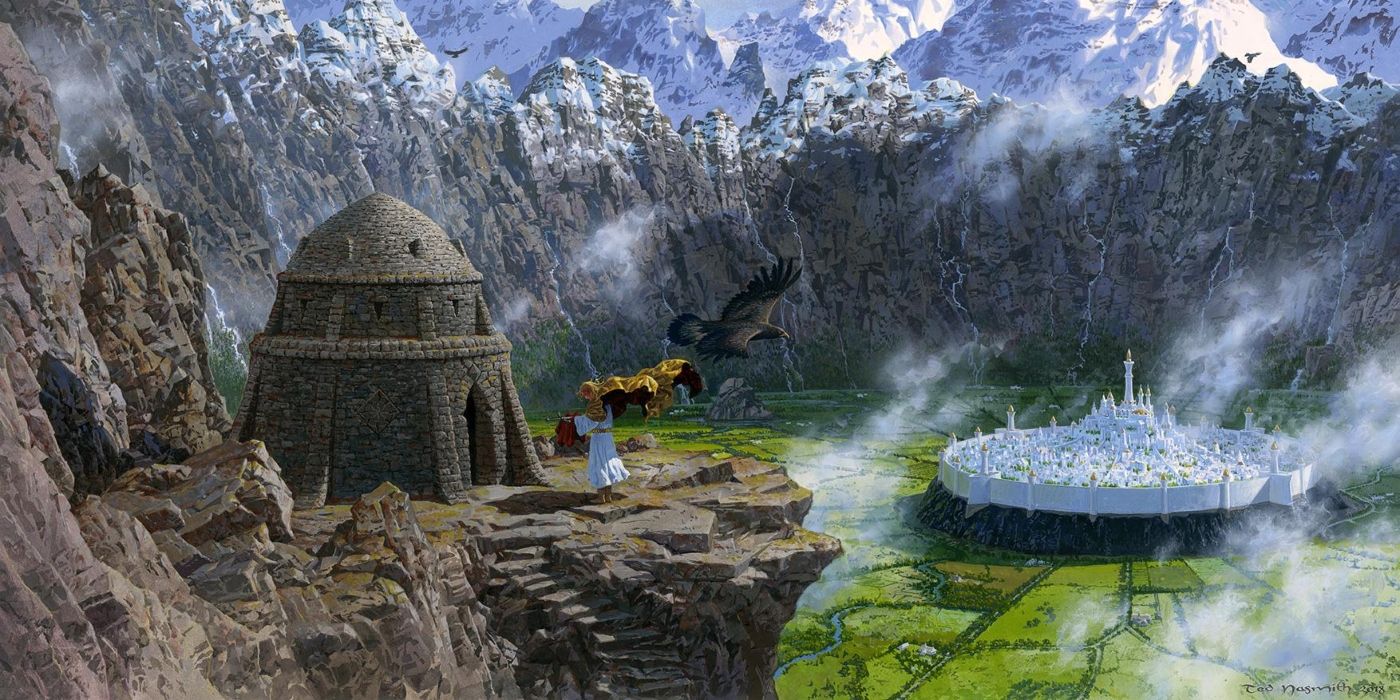What Are the Elven Realms in The Lord of the Rings?

The Elves are the most powerful of the Free Peoples of Middle-earth in The Lord of the Rings, but Peter Jackson‘s movies only show us a glimpse of their glorious realms. Prime Video’s The Lord of the Rings: The Rings of Power expands on that a little, but it’s still a fraction of what the Elves once were. However, J.R.R. Tolkien left a whole bibliography depicting their saga until the War of the Ring in the Third Age, showing us their many realms throughout the ages. It’s in The Silmarillion and Unfinished Tales that these are developed in depth, and it’s surprising how numerous the Elven realms once were.
Elven Realms Are Numerous in the First Age, but Some Stand Out
When the Elves first awakened in Cuviénen, to the far east, they began their journey to Aman, but some Elves opted to remain in Middle-earth, like Círdan the Shipwright (Ben Daniels) and most Silvan Elves, but the rest crossed the ocean to Aman. There, the Valar reside in Valinor, and the Elves established cities like Tirion, Alqualondë, and Avallónë, but there are other settlements, like Formenos. After Morgoth steals the Silmarils, however, the Noldorin Elves leave Aman in exile, and this begins their golden age in Middle-earth.
In the First Age, Middle-earth is very, very different from what we see in the movies. There’s a whole subcontinent to the northwest called Beleriand, which nearly doubles Middle-earth’s area, so there is enough space for Elves, Dwarves, and Men to establish countless realms of their own. Among the Elves, there are three main realms: Doriath, Nargothrond, and the hidden city of Gondolin. They are safe havens for the Elves scattered around Beleriand, in a time when Morgoth threatens the whole world. Besides them, there are other, smaller Elven settlements, especially in forests like Dorthonion and Sirion.
In the year F.A. 587, the Valar join the Free Peoples to finally defeat Morgoth, but the ensuing conflict, the War of Wrath, is so bloody that the Valar decide to sink Beleriand completely, resulting in the utter extinction of all Elven realms there. The only Elven domain left is Ossiriand, in East Beleriand, where the Green Elves dwell. The Noldor that remained in Middle-earth retreated there afterward, and it became known as Lindon, the new Elven capital in Middle-earth.
In the Second and Third Ages, Only a Handful of Elven Domains Survive
With the continent reshaped, Lindon became the main harbor in the west of Middle-earth. There, the Grey Havens are where those who sail to Aman depart, like Frodo (Elijah Wood) and Bilbo (Ian Holm) in The Lord of the Rings: The Return of the King. The ruler in the Second Age is Gil-galad (Benjamin Walker), the last High King of the Noldor, but, after he dies in the War of the Last Alliance, Círdan takes over as Lord of the Havens. By that time, however, the Light of the Eldar had started fading from Middle-earth, indicating that the Elves must depart to Aman soon.
Early in the Second Age, Celebrimbor (Charles Edwards) establishes the realm of the Elvensmiths, Eregion (or Hollin) next to the Misty Mountains. This is a short-lived city, though, as it falls to Sauron (Charlie Vickers) and his forces in S.A. 1697. One of the consequences is the founding of another Elven domain, Rivendell, by Elrond (Hugo Weaving/Robert Aramayo) in the valley of Imladris. Known as the Last Homely House East of the Sea, Rivendell is a haven for all who stand up to Sauron, and survives well into the Fourth Age. It’s also a haven for the Rangers of the North after the kingdoms of Men in Eriador fell in the Third Age.
On the other side of the Misty Mountains are two realms established by the Silvan Elves, but ruled by the Sindar. The first is Greenwood the Great, also known in the Third Age as the Woodland Realm and ruled by Thranduil (Lee Pace). When Sauron’s influence spreads over Rhovanion, Greenwood falls to darkness and is renamed Mirkwood, but the Elves remain. To the south is Lothlórien, ruled by Galadriel (Cate Blanchett/Morfydd Clark) and her husband, Celeborn (Marton Csokas). During the War of the Ring, both the Woodland Realm and Lothlórien are constantly attacked by Sauron’s forces in Dol Guldur, but survive into the Fourth Age.

Related
The Fourth Age Sees Two More Elven Realms Being Founded, but They Exist Only Briefly
With Sauron defeated, some regions were left in disarray after the War of the Ring, like the southern portion of Mirkwood, close to Dol Guldur. After they defeat the remnants of Sauron’s forces, Celeborn and the Galadhrim (Elven warriors from Lothlórien) establish the short-lived realm of East Lórien. Also, many cities of Men also see an influx of Elves, lasting for a few decades or centuries. One such place is Ithilien in Gondor, formerly known as Minas Morgul. Now under Faramir’s (David Wenham) leadership, Ithilien hosts many Elves led there by Legolas (Orlando Bloom) before they set for the bay of Belfalas in the south.
Eventually, all Elves leave Middle-earth for good. With the One Ring destroyed, the other Rings of Power also lose their magical properties, and are no longer able to conserve the Light of the Eldar in Middle-earth. This means that the Elves now must leave Middle-earth and return to Aman if they are to survive, otherwise they will fade into nothingness. Over the Fourth Age, most Elves took ships into the west, leaving Rivendell, the Grey Havens, Lothlórien, and the Woodland Realm eventually empty. These places also fade, until they are completely taken over by nature or Men to serve other purposes. As sad as it may be, Elves eventually become only a memory, just like their dwellings.






